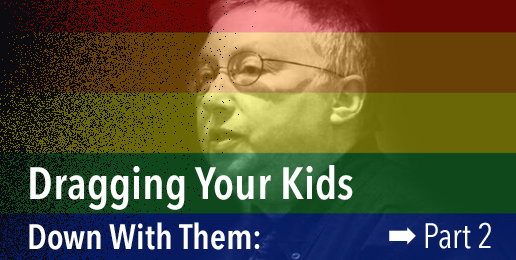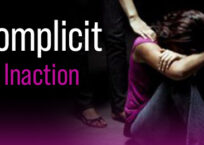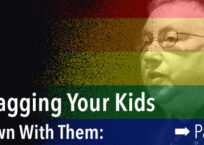
Last time, we pointed out the abnormally odd wickedness of drag queens and we asked the question: Why this? What possible worldview advocates for a man, dressed like a woman, wearing freakish makeup, and reading a sexually deviant book to third graders? Our search for the answer took us on a brief trip through queer theory, the philosophy committed to destroying traditional sexual ethics.
Queer theory shows us the intellectual roots of the hideous drag queen strategy.
Recall that, when looking at one of the founding queer theory articles, we uncovered two queer worldview principles.
First, rather than a stark divide between “licit” and “illicit,” sexual activity exists on a single spectrum that includes everything from married opposite-sex relationships at the top to the incestuous at the bottom—and thus everything is subtly legitimized.
Second, rather than making moral judgments, queer theory organizes sexual activity according to societal approval: Those at the top of the pyramid receive more favor from society, and those at the bottom receive more condemnation.
These two principles leave us with three conclusions. Fundamentally, sexuality is a social construct instead of an immutable fact of human nature. Therefore, those who are considered “perverted” are actually oppressed by the society that is refusing to approve of their particular kind of sexual behavior.
Finally, in order to liberate the oppressed, we need to change societal perception of their actions.
Enter drag. Drag shows attempt to “liberate” society by changing societal perception of sexuality. This insightful article from City Journal explains two ways in which it does so—it tears down established categories of gender and it elevates what was formerly sidelined.
How does drag erode established categories of gender? Well, there’s a reason we have different hairstyles, dress, and even subtle mannerism expectations for males and females. How you dress and how you act are real, tangible forms of communication and an important part of the sexual order. They ought to always line up with who you are.
However, if you’re a man wearing women’s clothing, you’re presenting mixed messages about who you are. And thus, you are blurring—and thus defying—the standard categories of male and female. Initially, you will be the one who is shocking because you are mixing things that obviously don’t go together. Yet, if you do this enough, eventually you will seem normal, the standard categories of male and female will appear malleable and revisable.
This comes straight from the queer theory handbook. Judith Butler, author of the treatise Gender Trouble (published in 1990) points out that there are three aspects to sexuality: your anatomical sex, your gender identity, and your “gender performance.”
She argued that when we see a man wearing women’s clothing,
“the reality of gender is also put into crisis: it becomes unclear how to distinguish the real from the unreal. And . . . we come to understand that what we take to be ‘real’ . . . is, in fact, a changeable and revisable reality” (p. xxiii).
There’s a reason why, in the Mosaic law, God explicitly prohibited men from wearing women’s clothing and told the Israelites that He detests anyone who cross-dresses (Deuteronomy 22:5).
It’s because we all have an obligation to communicate the truth about who we are. When drag performers make it acceptable to blur the lines, they attack the fundamental male-female distinction that God has established. They tell us that sexuality is a malleable aspect of our nature. And they “liberate” us from the fundamental male-female divide that God has established.
But that’s not all—let’s look at the second way that drag attempts to “liberate the oppressed” and tear down established categories: elevating sexual activity that was formerly sidelined. Drag doesn’t just blur what is natural. It takes what is (rightfully) unnatural and attempts to make it natural, too.
Recall that queer theory doesn’t label prostitution, sadomasochism, or incest as “wicked;” they’re just “less socially acceptable” than married sexual activity. Gayle Rubin, author of the 1984 article I referenced earlier, shows us a prime example of this kind of reasoning as she justified something no less abominable than pedophilia. Forget any question about whether pedophiles—or as she put it, “boylovers”—are wicked. According to Rubin,
“boylovers are so stigmatized that it is difficult to find defenders for their civil liberties, let alone for their erotic orientation,” and “these men have been the victims of a savage and undeserved witch hunt” (p. 147).
Thus, if drag performers openly celebrate perversions, they will desensitize and condition society to tolerate them, and thus the “oppressed” sexual activity will seem more normal. Without going into all the explicit details, this is why certain kinds of drag shows glorify such horrific abominations as pedophilia, necrophilia, object fetishism, and bestiality. After all, they’re liberating all those poor oppressed necrophiles.
Plus, they’re liberating us from the fundamental righteous-wicked divide that God has established.
Scripture recognizes the enhanced wickedness of parading the sin that you’re committing, and Scripture pronounces a resounding woe upon such strutting (Isaiah 3:9). One of the reasons why parading sin is so egregious is because it normalizes it to those around you. And drag capitalizes on that.
Admittedly, not all forms of drag glamorize the kind of trash I just described. City Journal observes that while one strain of drag has moved into darker and darker transgression, another strain has done its best to infiltrate the mainstream by presenting itself as innocent fun.
However, even the drag performers that paint themselves as “family-friendly” still promote the same basic theory and still perform the same basic function of inverting traditional sexuality. This brings us to the final aspect of our discussion. Why is drag in the third grade classroom?
We’ve seen that drag fits perfectly into the queer worldview. By changing societal perceptions of normal sexuality and abnormal sexuality, it attempts to liberate those who are sidelined by changing societal perception of their actions. So let’s tackle the last step of the story: Why they’re going after your kids.
Read more: Dragging Your Kids Down With Them: Part 1























